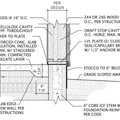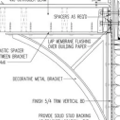Air source or air to water heat pumps
Hello,
New here and no expert on any of this stuff. Trying to figure out best way to move away from fossil fuels. I live in the suburbs of New York City so we get fairly cold winters and hot summers (I think it’s climate zone 5A or 4A based on the climate zone map).
Our current setup is the following:
HEAT (oil furnace):
– main level of the house (living room, dining room, kitchen, laundry) is heated with radiant floor heating only. There are 8 different zones. Forced air heating is also an option on this level of the house, but we generally prefer the floor heating as it seems to heat things more evenly. We have occasionally turned on the forced air on very cold days and tried to direct the air towards the living room which has very high ceilings (living room space is essentially 2 floors). Each room has at least 1 floor vent/register, and the return is in the basement. The air handler is in the basement utility room. Ductwork is in the walls. When we have turned off the radiant heating and switched to the forced air, the house is fairly comfortable, but it doesn’t seem to make sense to have the return be in the basement as all the warm air seems to get “stuck” in the staircase going down to the basement.
– bedroom level (upstairs 3 bedrooms including ensuite bathroom for primary bedroom, small hallway, and 1 hall bathroom) is heated with forced air. Each room has a ceiling vent/register and the return is in the hallway. The bathroom also has floor heating, which we like. Ductwork is in the attic and is exposed and probably needs to be reconfigured as one bedroom always feels a little colder. Air handler is in the attic.
COOLING:
2 zones and 2 condensers outside. Basement air handler does the forced air cooling for the basement and the main level. Attic air handler does the forced air cooling for the upstairs level. No complaints on the cooling system.
Air handlers are 12 years old and working fine.
We also have a gas boiler for a tankless hot water heater, gas stove, and gas dryer. And a driveway/walkway snow melt. We rarely turn on the snow melt, and when we do, we don’t leave it on very long. It’s not hard to shovel our driveway and walkway when there’s snow! We are willing to abandon the snow melt.
We are having solar panels installed to cover our current electricity usage, and there would be room to add more panels should we go fully electric.
HERE ARE MY QUESTIONS/THOUGHTS:
We have gone through various scenarios and we can’t figure out what makes the most sense:
– getting air to water heat pumps so we can keep the radiant floor heating on the main level and using air to water heat pumps for the radiant and the forced air heating/cooling. Adding electric boiler as backup. Keep gas furnace for water heater, stove, dryer, and snow melt.
– abandon floor heating and get air source heat pumps for the forced air heating/cooling in the whole house. Fix ductwork (add a return to main level of the house and reconfigure attic ductwork for more even heating).
– air source heat pumps for forced air heating/cooling in the whole house and fix ductwork AND connect radiant floor heating to an electric boiler to only use as backup.
Finally, what are options for hot water heaters in all above scenarios? We don’t really care about the snow melt so we would be fine to get rid of the gas furnace if we can figure out something else for the hot water heater (and get electric dryer and stove).
Thank you for any and all advice!!
GBA Detail Library
A collection of one thousand construction details organized by climate and house part










Replies
The simplest would be to replace the oil boiler for the floor heat with an air to water heat pump and replace the AC units with cold climate air to air heat pumps. Properly sized the combination of the two heat sources would easily cover your space heat needs even during polar vortex events. It also means relatively simple install and you would only have to find spot for one more outdoor unit.
This gets you mostly off fossil fuels. The rest (hot water, snow melt, dryer, range) I would revisit once the equipment needs to be replaced.
The first step before any of this though is to figure out your actual heat load is. Since we just went through a good cold snap, you can run through the math here using a recent fuel bill:
https://www.greenbuildingadvisor.com/article/replacing-a-furnace-or-boiler
I don’t see anything simple about upgrading the hydronic system!
The way I see it in any climate that requires cooling having hydronic heating is a very expensive luxury.
I am OK with that so long as one clearly sees that fact and decides they want to pay for that luxury.
If what is most important is the lowest cost system to install and operate not using the city gas, them upgrade to air to air heat pumps is a good choice.
If what is most important is the lowest cost system to install and operate, then keep the current boiler running on city gas for the next 50 year is a good choice.
If what is most important is to cut the gas pipe from your home upgrading to a HP is one step then the question is do you want to give up the luxurious hydronic system?
In my opinion the least green thing anyone can do is to throw perfectly good equipment into the landfill on a whim with the thought they are saving the earth.
In my mind this plan only makes sense if and when the current equipment has been deemed unsafe or unrepairable and NOT simply old and likely to fail soon anyway.
Walta
I'd have to second this. Why throw away perfectly good materials/equipment? What about either installing the extra solar now and getting paid by the electric company for the extra power until the equipment requires replacing or adding additional solar panels later when the current equipment needs to be replaced?
Would also probably be good if you could move the hvac system in the attic into the conditioned space when it is time to replace it, if possible.
Thank you for your reply. You make a good point about keeping equipment if it’s working. The oil furnace is definitely in need of replacement. So I guess my question here is: can current oil furnace be replaced by an electric boiler? Can an electric boiler be hooked up to my current floor heating and forced air heating/cooling?
Thanks!
Often when air conditioning is installed after a hydronic system, the ductwork is sized only for cooling, and in a heating-dominated climate that means they're undersized for heating. So keeping the radiators and running them at reduced output while also running heating through the ductwork allows you to keep the ductwork while going all heat pump.
When you're getting your heat from a heat pump, the only viable way to get hot water is a standalone water heater. Either a heat pump or gas.